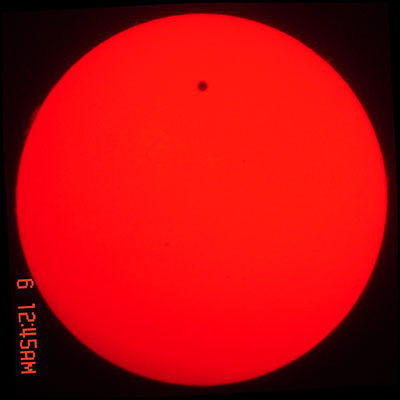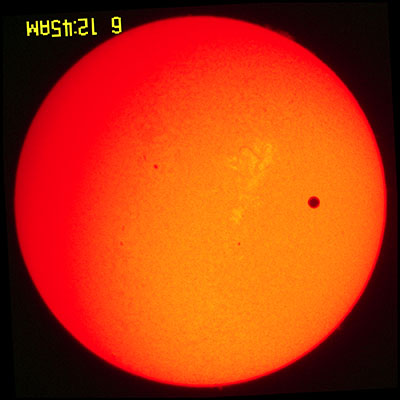.
For more than fifty years I have been planning to observe the transit of Venus. I first learned about transits of the inner planets (Mercury and Venus) in 1960, when a Mercury transit was observed by the astronomy club at Scotia-Glenville High School. On June 5 I was able to photograph the transit of Venus from near the summit of Mt. Haleakala on Maui, accompanied by my daughter, brother-in-law and nephew, and their families. It was worth the wait. Admittedly, I had already observed the earlier transit in 2004, but not in such a spectacular setting, or with as much equipment.
The trip to Maui was planned several years in advance because Hawaii was one of the best places for observation. The combination of location, which allowed the entire transit to be seen, and the likelihood for clear skies atop Haleakala were the most important factors. (OK, a trip to Maui was a draw in itself!)
As most of you probably know, transits of Venus, when Venus passes directly between the Earth and the Sun, are very rare events. They occur generally in pairs eight years apart, followed by a gap of 105 or 122 years. The next time to see this event will be 2117. The sight of the black dot of Venus moving across the face of the Sun is a bit awe-inspiring, even more when one is aware of its rarity.
In preparation for the event I was able to borrow two solar telescopes to make the observations easier, and to be able to see additional details of the sun, including solar prominences extending outward from the edge of the solar disc. Ed Stander from SUNY Cobleskill and Howard Mooers of University of Minnesota-Duluth provided these instruments. Francis Wilkin, of the Union Department of Physics and Astronomy provided additional equipment. My daughter, Katherine, who teaches at Green River Community College in Auburn, Washington, played a key role in photographing images through one of the telescopes. This was a truly cooperative venture.
We arrived in Maui on June 3 and spent part of the next day doing a “trial run”, driving up the slopes of Haleakala to the National Park that covers the mountaintop. Just inside the park entrance is a visitor center with a convenient location for setting up telescopes. Initially we planned to drive to the other visitor center near the summit, but as the lower location was well above the clouds, we decided to use it instead, especially since we expected large crowds at the summit. As it turned out, this was not the best idea.
On June 5 we drove to the lower visitor center and set up the equipment at about 11:00 AM. The transit was due to begin shortly after noon, so we had plenty of time. About 20 minutes before the start, clouds began to threaten to block the sun. We quickly decided to move the photographic telescope up the mountain, leaving part of the group and the visual telescope. Katy and I grabbed the telescope and camera and quickly drove a couple of miles along the ascending road to a parking lot well above the clouds (or so we thought). Because we had had practice setting up the equipment we were able to start recording a video of Venus crossing the edge of the Sun and entering the solar disc. This stage of the transit takes about twenty minutes, and we wanted to record it in detail.
As luck would have it, out location was far enough to the northwest, that we were on the edge of the weather front produced by the volcano in conjunction with the trade winds, which were blowing strongly. We did record almost the entire ingress, but clouds obscured the very last stages, and forced us to move still higher on the mountain. We communicated with the rest of the party down the slopes (they had been able to see a fair amount of the start, as it turns out), and we all moved to the upper visitor center near the summit. This took about 15-20 minutes, but again, our practice paid off and we were soon taking photographs of the transit, about one a minute for the next four to five hours. It turned out that there was not a large crowd at the summit, with about 10 telescopes set up by an interesting array of amateur astronomers. Several tourists made the rounds of the telescopes, exclaiming with delight at what they could see. Some had not been aware that a transit was in progress. One ten-year-old girl said she was planning to be an astronomer when she grew up.
Most of the transit was routine, monitoring the photography (Katy was invaluable in getting focus correct) and occasionally glancing through the optical telescope to see the black dot of Venus. About 25 minutes before the end, as Venus was about to cross the edge of the solar disc we switched back to video mode, and recorded the final phases. When the last bit of Venus left the sun there were cheers of delight. We packed up our gear and headed down the mountain to enjoy the more usual delights of a Maui holiday.

